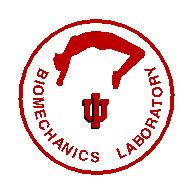
Department of Kinesiology

Jesus Dapena
Animations of High Jumping
You can download two computer animations of high jumps from this page.
The first animation shows an actual jump, analyzed through 3D filming methods. The second jump is an animation of an artificial jump generated using computer simulation. In this jump, we kept the conditions in the run-up and takeoff the same as in the first jump, except that we had the athlete take off a little bit farther from the bar. So the height reached by the athlete's center of mass was the same as in the original jump, and her angular momentum (or "rotary momentum", a factor that plays an important role in determining the rotation of the athlete) after takeoff was also the same as in the original jump. But then, in the air, we made the knees flex very much as the athlete traveled up toward the bar. This made her body be more compact in the view along the bar, and therefore made her somersault backward faster than in the original jump. We also improved her arch at the peak of the jump, and then made her un-arch with good timing. The result was a simulated jump in which the athlete would have been able to clear a bar set much higher than in the original jump.
To facilitate the identification of the two animations, in the original jump the ground is shown in its true color (pink), while in the simulated jump the ground is green.
The files are in two formats:
MOV format file of original jump (0.7 MB)
MOV format file of simulated jump (0.7 MB)
AVI format file of original jump (1.2 MB)
AVI format file of simulated jump (1.2 MB)
The MOV files have higher quality images.
Download the files (right-click on the links above --preferably the MOV links-- and select "Save Target As" or "Download Link to Disk"). Then, open each file with QuickTime, which will enable you to use single-frame advance. If the movie does not loop (repeat over and over) when played, click on Movie-Loop. Then use the right and left arrows of the keyboard to single-frame advance in order to see clearly the differences between the bar clearances of the original jump and of the simulated jump.
Return to:
Jesus Dapena Research
Jesus Dapena Home Page
Department of Kinesiology Home Page
School of Public Health Home Page
Last updated: June 2004
URL: http://sportbm.publichealth.indiana.edu/research/hj-animations.html
Comments: 
Copyright
2004, The Trustees of Indiana University